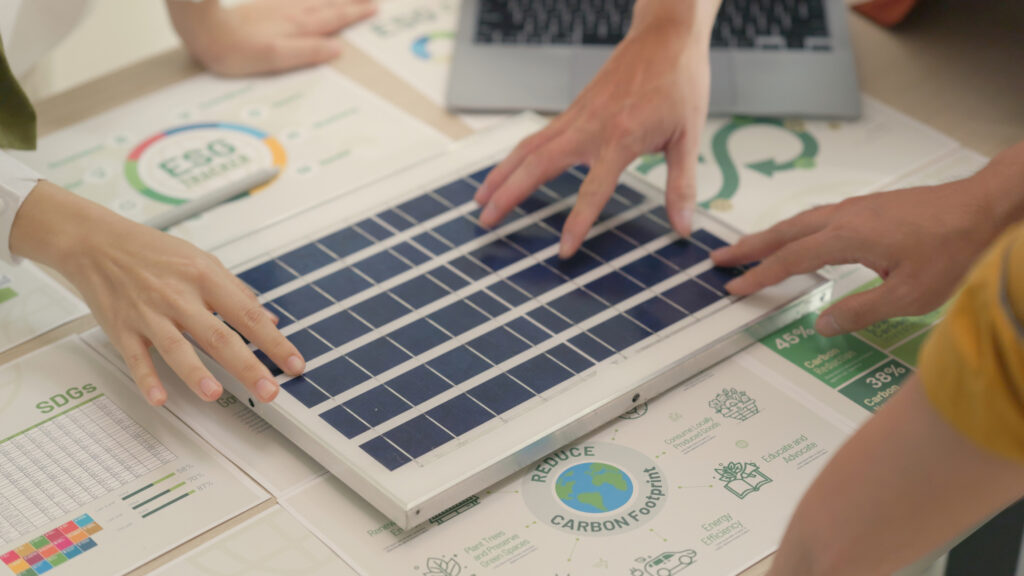With the rate of solar installations in the United States (U.S.) continuing to soar – over 5 million installations equivalent to 200 GW of green solar electricity capacity as of Q1 2024, there is a new standard for managing end-of-life solar panels: 100% recycling. It is expected that more than 1 million end-of-life solar panels per year will need a responsible, environmentally sustainable end-of-life destination by 2030, and tens of millions each year by 2050.
We are hearing from our customers that eliminating the contaminant risk of recycling, achieving economics that can scale, and rapidly scaling that industrial capacity is key to closing the green loop for solar energy. And they want more of it. We are listening.
Dr. Fortunato Villamagna, President of Comstock Metals

What is Closed Loop Solar?
A closed-loop solar future for the U.S. envisions a sustainable and closed-loop economy where solar panels are not only an affordable source of renewable energy but also 100% recyclable at the end of their lifecycle so that 100% of the solar panel can be recycled to recover 100% of a panel’s materials, to be efficiently reused in new panels or other products.
A closed loop approach not only mitigates environmental impact and aligns with broader environmental goals, but it strengthens the U.S. economy by creating jobs in recycling and manufacturing sectors.
Taylor Curtis, a sustainability analyst at the National Renewable Energy Laboratory (NREL), emphasizes that “responsible and cost-effective management of PV system hardware is an important business and environmental consideration.”
Achieving 100% recycling to close the solar loop economically for the market can significantly reduce resource constraints for the electrification economy and end the practice of sending solar panels to landfills, while also stimulating economic growth. You can read more about this vision for a closed loop economy for solar photovoltaic system materials on the NREL website (NREL Home).
How Are End-of-Life Solar Panels Recycled Today?
Primary Recycling Today: First, solar panels are typically dismantled to separate materials from each other, such as silicon, silver, aluminum, and glass. Laminates (polymers or “plastics”) are adhesives which bind the components of panels together and it is in these plastics where most contaminates are found. Typical destruction processes used today are mechanical and chemical. However, thermal processing can ensure the maximum elimination of contaminants.
Secondary Recycling Process: Second, recovered materials are refines. For example, crushed materials such as glass is “cleaned” using washes to process into new glass products. Or metals are smelted. In both cases, if contaminants have not been properly eliminated prior to this stage, the risk of them continuing to move downstream into other manufacturing processes and into new products is still present.
How is Comstock Metals’ 100 Recycling Process Different?

We have made it our mission to deliver on the promise of the closed loop. We believe this should be the new solar panel recycling standard. By prioritizing 100% recycling, we can ensure that the benefits of solar energy do not come at the expense of environmental and human health. And we will have also achieved this at an economic cost for our customers that is equivalent to existing disposal costs.
What Products Come From Comstock Metals’ Process?
In the Comstock Metals 100% recycling process, we create four products. 1) The first cut is metal flakes, and those go to conventional metal recycling. 2) The second cut is the ground glass, which also goes to a conventional bottle recycler. 3) The third and fourth cuts are of different particle sizes called fines. These contain the metal oxides that will go to smelters to have the component metals recovered. You can see more of this process and these materials here in this video about our recycling center.

State of Affairs of Solar Panel Recycling Regulation
Solar panels are currently classified as either solid waste or universal waste in a few states such as California and Hawaii. Solid waste regulations in the United States are governed by a comprehensive framework designed to ensure proper management and disposal of general waste to protect public health and the environment. These regulations are primarily established under the Resource Conservation and Recovery Act (RCRA) and are implemented by the Environmental Protection Agency (EPA) along with state and local governments.
Solid waste is a broad category that includes diverse types of refuse, while universal waste specifically refers to certain types of hazardous waste that have been found to include certain contaminants that are known to have been found in some types of solar panels such as cadmium or lead.
The Universal Waste Rule, which was first established by the EPA in 1995, covers items such as batteries, pesticides, mercury-containing equipment (like thermostats), computers, cell phones, and certain types of bulbs (such as fluorescent lamps), which require separate and specific disposal and handling, but does not yet include solar panels. The trend is designating end-of-life solar panels as universal waste because of their potential toxicity.
Let’s Make 100% Recycling The Industry Practice
We believe universal acceptance to designate end-of-life solar panels as universal waste would create a solar ecosystem that is closed loop, and it would ensure that one state isn’t pushing potentially toxic contamination from their no-landfill policies to other areas of the country, or as an export to other countries.
As an industry standard, 100% recycling ensures that as the volume of end-of-life solar panels increases and they go to a solar panel recycling center such as Comstock Metals in one state, even if they cross state or county lines, the contamination risk is eliminated, and everyone benefits from a shared resource that helps make solar greener as a resource solution for the whole solar supply chain, that is better in every way than sending solar panels to landfills.
As of June 2024, the EPA has a proposed new universal waste rule for end-of-life solar panels under consideration. You can read more here: rulemaking and here about universal waste regulations. A final rule is expected in 2026.
Is 100% Solar Panel Recycling Cost-Competitive?
Costs for existing universal waste disposal on average are about $500 per ton (as of June 2024). Costs for solid waste at landfills averages about $50 per ton. The trend is toward policy and industry expectations to move toward treating solar panels as universal waste AND away from any recycling solution that does not eliminate 100% of contamination, bending toward choosing recycling over landfills.
The tipping fees we charge as a 100% full-service end-of-life solar panel recycling service that eliminates 100% of the contamination risk and ensures none of the solar panel winds up in landfills is cost-competitive to current disposal methods.

The Risks Are Not Worth the Wait
The fact that certain types of solar panels contain hazardous materials, which can leach into the soil and groundwater if not effectively managed is a fact.
While regulations advance toward universal waste designation, today the primary environmental hazard associated with landfilling solar panels remains the potential for leachate contamination. This risk only escalates as volume of panels in landfills gets larger. Consider the Erin Brockovich case of groundwater contamination. Some might argue this is an overly dramatic comparison, that leachate from solar panels is a small risk, but the case that Brockovich brought attention to about the contamination of drinking water in Hinkley, California, caused by hexavalent chromium, underscores why zero landfill is such an important standard to achieve.
Even the smallest risk of potential human and environmental harm is too much of a risk. This is why 100% recycling should be the new standard for end-of-life management of solar panels.
Our Solution
Media
Sources
U.S. Environmental Protection Agency. “Managing End-of-Life Photovoltaic Panels.” EPA, 2021.
National Renewable Energy Laboratory. “Photovoltaic Decommissioning and Recycling.” NREL (National Renewable Energy Laboratory), 2019.
Solid Waste Association of North America. “Cost of Landfill Disposal in the United States.” SWANA, 2022.
U.S. Environmental Protection Agency. “Proposed Rules for Photovoltaic Module Management.” EPA, 2023.
International Renewable Energy Agency. “End-of-Life Management of Solar Photovoltaic Panels.” IRENA, 2016.
Solar Energy Industries Association. “Recycling Solar Panels: An Emerging Industry.” SEIA, 2020.
U.S. Environmental Protection Agency. “Proposed Rules for Photovoltaic Module Management.” EPA, 2023.
Brokovich, E. “The Case Against Hexavalent Chromium.” Brokovich Environmental Advocacy, 1996.


